Abstract
A test of muscle strength and "fatiguability" was administered to 20 normal subjects and 20 patients suffering from post-infection fatigue syndrome. Maximal isometric torque for the elbow flexors was measured before, during and after an endurance sequence of 18 maximal static contractions (10 s duration, 10 s rest interval). The maximal isometric strength was not significantly different between the patient and control groups. The relative torque produced at the end of the series of 18 static contractions did not differ significantly between patients and normal subjects. In the patients with post-infection fatigue syndrome there was impairment of the recovery of peak torque at 10 minutes after the endurance sequence (p less than 0.02). The prominent subjective complaint of muscle fatigue in patients with post-infection fatigue syndrome contrasts with the relatively normal behaviour of their muscles during a controlled test of fatigue. The syndrome may include a disordered perception of achieved force and exertion.
Full text
PDF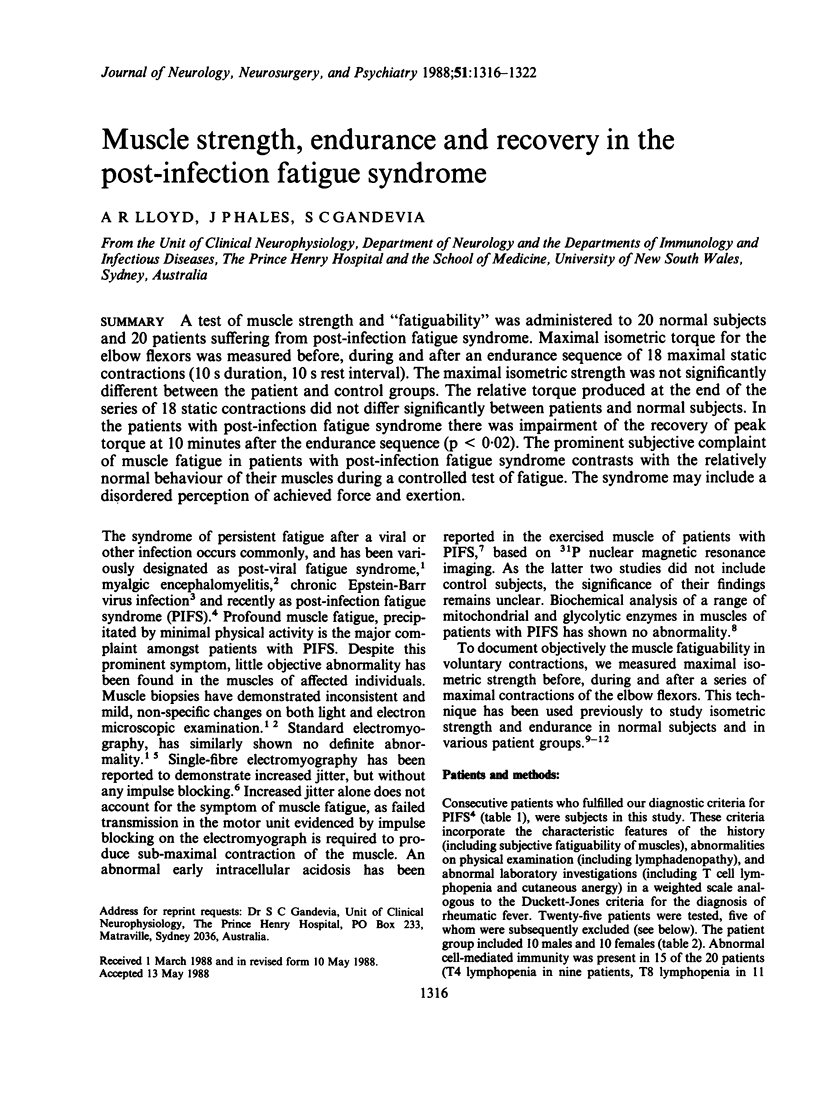
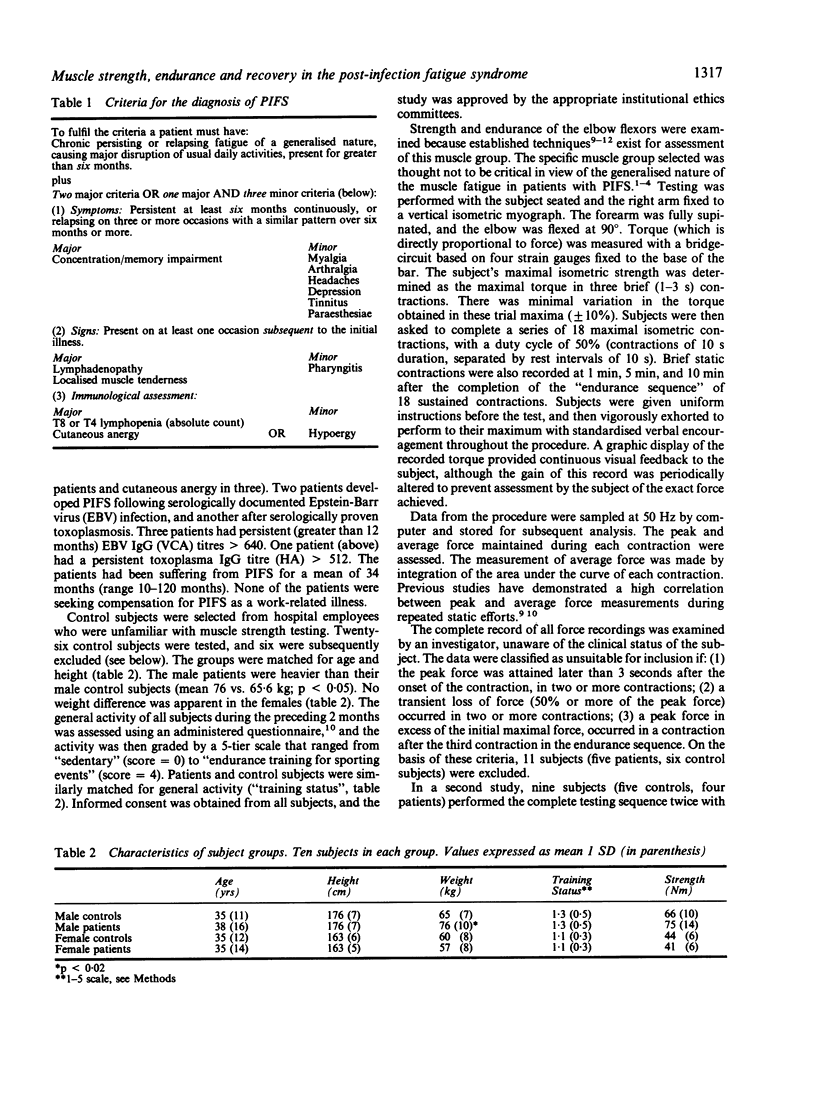
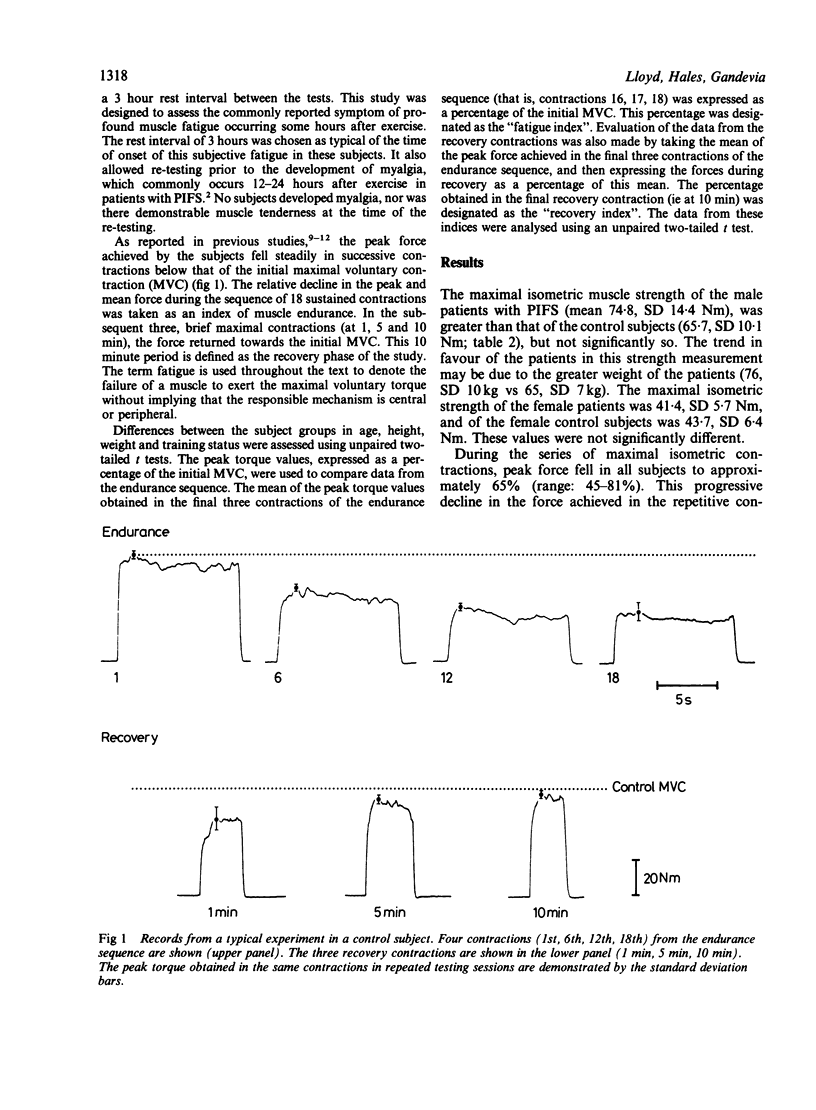
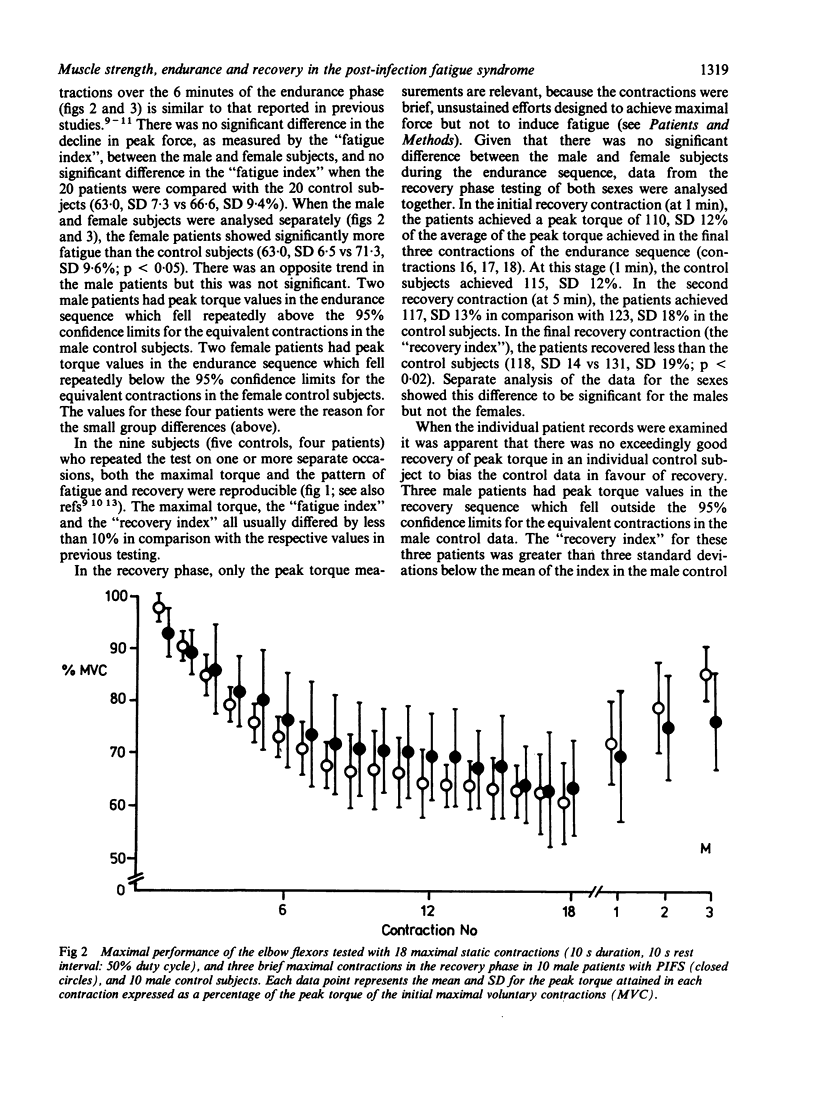
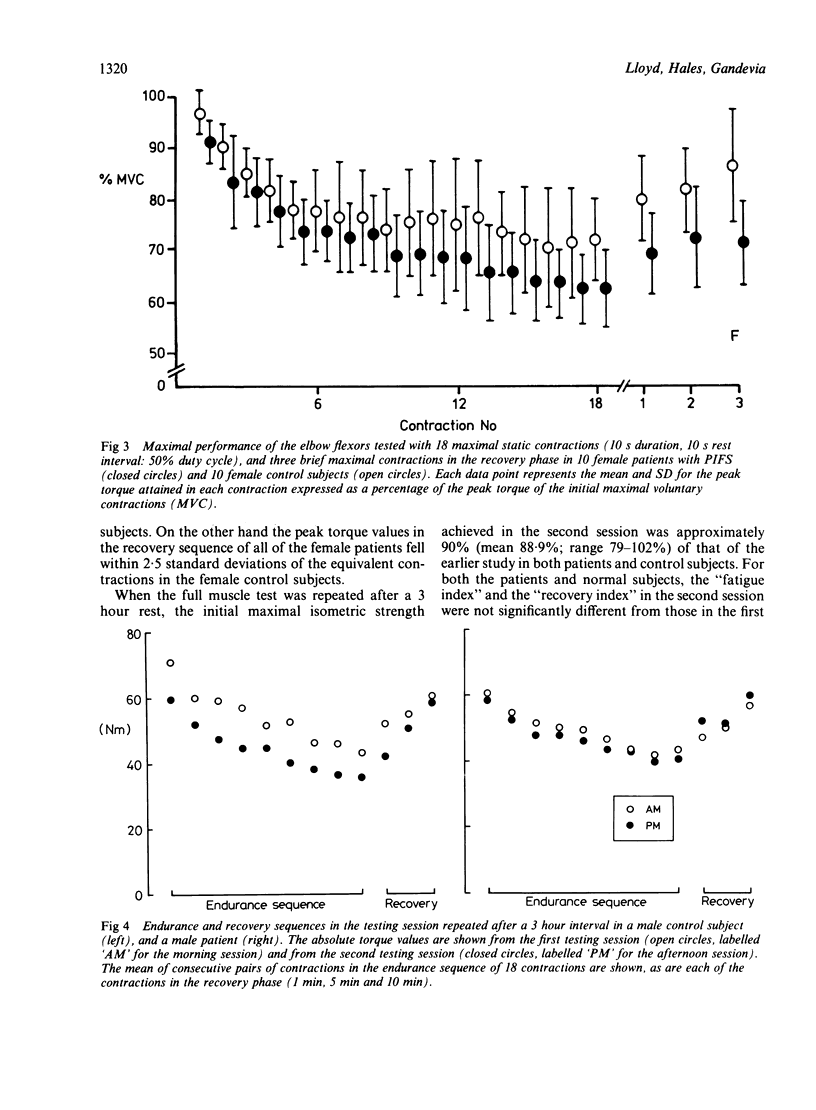
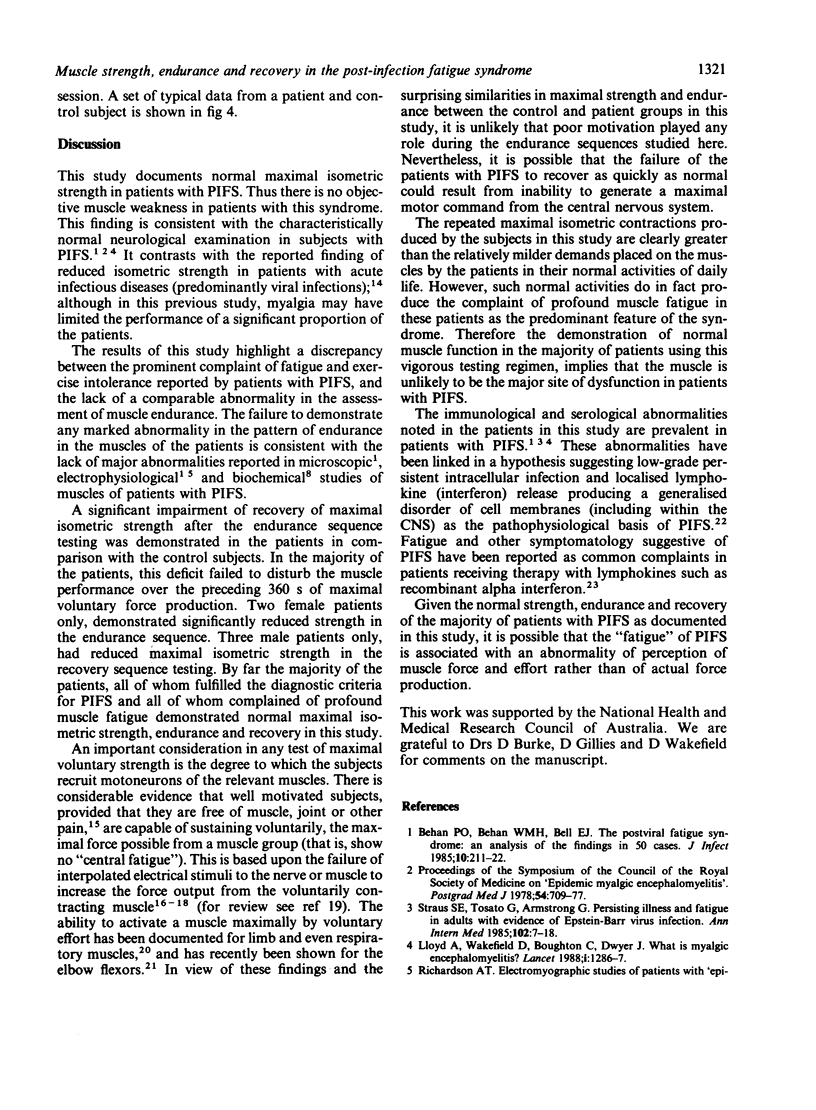
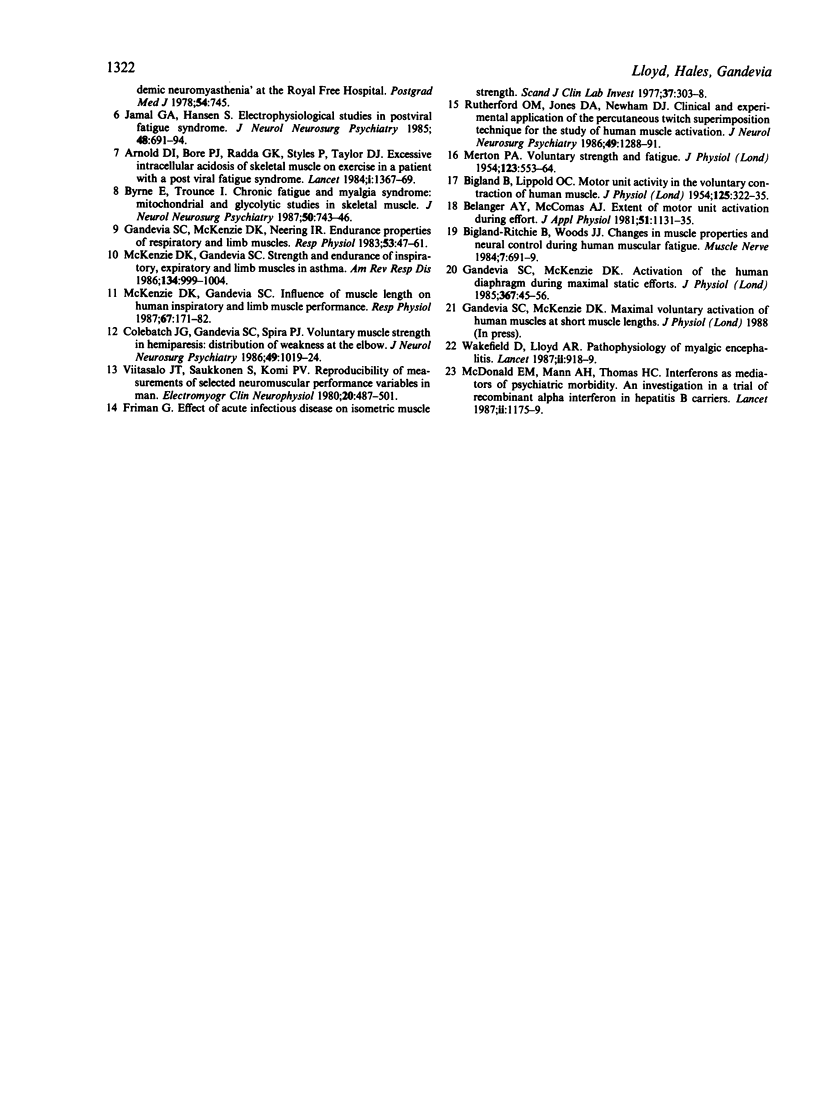
Selected References
These references are in PubMed. This may not be the complete list of references from this article.
- Arnold D. L., Bore P. J., Radda G. K., Styles P., Taylor D. J. Excessive intracellular acidosis of skeletal muscle on exercise in a patient with a post-viral exhaustion/fatigue syndrome. A 31P nuclear magnetic resonance study. Lancet. 1984 Jun 23;1(8391):1367–1369. doi: 10.1016/s0140-6736(84)91871-3. [DOI] [PubMed] [Google Scholar]
- BIGLAND B., LIPPOLD O. C. Motor unit activity in the voluntary contraction of human muscle. J Physiol. 1954 Aug 27;125(2):322–335. doi: 10.1113/jphysiol.1954.sp005161. [DOI] [PMC free article] [PubMed] [Google Scholar]
- Belanger A. Y., McComas A. J. Extent of motor unit activation during effort. J Appl Physiol Respir Environ Exerc Physiol. 1981 Nov;51(5):1131–1135. doi: 10.1152/jappl.1981.51.5.1131. [DOI] [PubMed] [Google Scholar]
- Bigland-Ritchie B., Woods J. J. Changes in muscle contractile properties and neural control during human muscular fatigue. Muscle Nerve. 1984 Nov-Dec;7(9):691–699. doi: 10.1002/mus.880070902. [DOI] [PubMed] [Google Scholar]
- Byrne E., Trounce I. Chronic fatigue and myalgia syndrome: mitochondrial and glycolytic studies in skeletal muscle. J Neurol Neurosurg Psychiatry. 1987 Jun;50(6):743–746. doi: 10.1136/jnnp.50.6.743. [DOI] [PMC free article] [PubMed] [Google Scholar]
- Colebatch J. G., Gandevia S. C., Spira P. J. Voluntary muscle strength in hemiparesis: distribution of weakness at the elbow. J Neurol Neurosurg Psychiatry. 1986 Sep;49(9):1019–1024. doi: 10.1136/jnnp.49.9.1019. [DOI] [PMC free article] [PubMed] [Google Scholar]
- Corey L., Whitley R. J., Stone E. F., Mohan K. Difference between herpes simplex virus type 1 and type 2 neonatal encephalitis in neurological outcome. Lancet. 1988 Jan 2;1(8575-6):1–4. doi: 10.1016/s0140-6736(88)90997-x. [DOI] [PubMed] [Google Scholar]
- Friman G. Effect of acute infectious disease on isometric muscle strength. Scand J Clin Lab Invest. 1977 Jun;37(4):303–308. doi: 10.3109/00365517709092633. [DOI] [PubMed] [Google Scholar]
- Gandevia S. C., McKenzie D. K. Activation of the human diaphragm during maximal static efforts. J Physiol. 1985 Oct;367:45–56. doi: 10.1113/jphysiol.1985.sp015813. [DOI] [PMC free article] [PubMed] [Google Scholar]
- Gandevia S. C., McKenzie D. K., Neering I. R. Endurance properties of respiratory and limb muscles. Respir Physiol. 1983 Jul;53(1):47–61. doi: 10.1016/0034-5687(83)90015-4. [DOI] [PubMed] [Google Scholar]
- Jamal G. A., Hansen S. Electrophysiological studies in the post-viral fatigue syndrome. J Neurol Neurosurg Psychiatry. 1985 Jul;48(7):691–694. doi: 10.1136/jnnp.48.7.691. [DOI] [PMC free article] [PubMed] [Google Scholar]
- MERTON P. A. Voluntary strength and fatigue. J Physiol. 1954 Mar 29;123(3):553–564. doi: 10.1113/jphysiol.1954.sp005070. [DOI] [PMC free article] [PubMed] [Google Scholar]
- McKenzie D. K., Gandevia S. C. Influence of muscle length on human inspiratory and limb muscle endurance. Respir Physiol. 1987 Feb;67(2):171–182. doi: 10.1016/0034-5687(87)90039-9. [DOI] [PubMed] [Google Scholar]
- McKenzie D. K., Gandevia S. C. Strength and endurance of inspiratory, expiratory, and limb muscles in asthma. Am Rev Respir Dis. 1986 Nov;134(5):999–1004. doi: 10.1164/arrd.1986.134.5.999. [DOI] [PubMed] [Google Scholar]
- Rutherford O. M., Jones D. A., Newham D. J. Clinical and experimental application of the percutaneous twitch superimposition technique for the study of human muscle activation. J Neurol Neurosurg Psychiatry. 1986 Nov;49(11):1288–1291. doi: 10.1136/jnnp.49.11.1288. [DOI] [PMC free article] [PubMed] [Google Scholar]
- Straus S. E., Tosato G., Armstrong G., Lawley T., Preble O. T., Henle W., Davey R., Pearson G., Epstein J., Brus I. Persisting illness and fatigue in adults with evidence of Epstein-Barr virus infection. Ann Intern Med. 1985 Jan;102(1):7–16. doi: 10.7326/0003-4819-102-1-7. [DOI] [PubMed] [Google Scholar]
- Viitasalo J. T., Saukkonen S., Komi P. V. Reproducibility of measurements of selected neuromuscular performance variables in man. Electromyogr Clin Neurophysiol. 1980 Oct-Dec;20(6):487–501. [PubMed] [Google Scholar]
- Wakefield D., Lloyd A. Pathophysiology of myalgic encephalitis. Lancet. 1987 Oct 17;2(8564):918–919. doi: 10.1016/s0140-6736(87)91408-5. [DOI] [PubMed] [Google Scholar]


